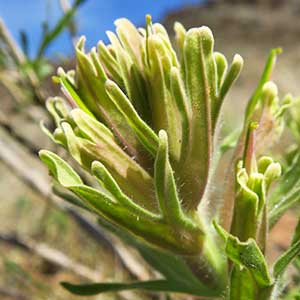Castilleja xanthotricha
Castilleja peckiana
John Day or yellow-hairy paintbrush, John Day paintbrush, yellow hair paintbrush, yellow-hair Indian paintbrush
peak paintbrush, Peck's Indian paintbrush, Peck's paintbrush
few to several, ± decumbent to erect or ascending, unbranched, sometimes with short, leafy axillary shoots, hairs erect to spreading, long, soft, eglandular, mixed with short stipitate-glandular ones.
few to many, erect or ascending, often branched distally, sometimes unbranched, sometimes with short axillary shoots, proximal hairs retrorse to appressed, short to moderately long, distal hairs spreading, longer, soft, often mixed with short stipitate-glandular ones.
green, linear, lanceolate to broadly lanceolate, oblong, or cuneate, 0.8–5 cm, not fleshy, margins plane to wavy, involute, 0–5-lobed, apex acute, sometimes rounded;
lobes spreading, linear, arising below mid length, nearly as broad as center lobe, apex acute.
green, linear-lanceolate, rarely broadly lanceolate, (1.2–)2.5–8(–9) cm, not fleshy, margins plane, flat or involute, 0(–3)-lobed, apex acute to rounded;
lobes ascending-spreading, narrowly lanceolate to linear, apex acute or obtuse.
3–14 × 1.5–4.5 cm;
bracts proximally greenish, rarely dull reddish purple, distally white to cream, rarely pale yellow or dull, pale pink (sharply differentiated from proximal coloration), lanceolate or oblong to narrowly ovate, (3–)5–7-lobed;
lobes ascending, linear to obovate, ± broadened distally, medium, long, proximal lobes arising below mid length, central lobe apex broadly rounded to truncate, others acute to rounded.
(2–)4–17 × 1.5–3 cm;
bracts proximally greenish, distally red, orange-red, or orange, proximal sometimes lanceolate, distal broadly lanceolate to ovate, (0–)3(–7)-lobed;
lobes spreading to ascending, linear to lanceolate, long, arising near or below mid length, central lobe apex rounded, lateral ones acute.
curved, 17–23 mm;
tube 15–19 mm;
beak exserted, adaxially green, 5–8(–9) mm, puberulent, stipitate-glandular;
abaxial lip deep purple (color sometimes visible through calyx), green, pinkish, or pale yellow, ± prominent, slightly inflated, usually hidden in calyx, sometimes right at top of calyx, 2 mm, ca. 50% as long as beak;
teeth ascending, whitish, yellowish, pink, or green, 1–1.5 mm.
straight, 23–30(–35) mm;
tube 12–20 mm;
beak exserted, adaxially green, 8–12(–14) mm;
abaxial lip pale to deep green, reduced, rounded, 0.5–1.5 mm, 10–20% as long as beak;
teeth erect to incurved, green, (0.4–)0.7–1.2(–2) mm.
colored as bracts, 15–26 mm;
abaxial and adaxial clefts 3.5–7 mm, 25–50% of calyx length, deeper than laterals, lateral 2–5 mm, 12–25% of calyx length;
lobes linear, oblong, or narrowly triangular, center lobe apex usually rounded, lobes acute to rounded.
proximally pale yellow or greenish, distally colored as bracts, (15–)18–28 mm;
abaxial and adaxial clefts 6–12 mm, 40–45% of calyx length, deeper than laterals, lateral 2.5–8 mm, 20–30% of calyx length;
lobes linear to narrowly lanceolate, apex acute to acuminate.
= 48.
= 72, 96, ca. 120.
Castilleja xanthotricha
Castilleja peckiana
Castilleja xanthotricha is endemic to moderate elevations in the sagebrush hills of the John Day River drainage in north-central Oregon. N. H. Holmgren (1971) hypothesized that this tetraploid species is of allopolyploid hybrid origin between C. glandulifera and C. oresbia.
(Discussion copyrighted by Flora of North America; reprinted with permission.)
When describing Castilleja peckiana, Pennell noted that its variation approached C. hispida on one hand and C. miniata on the other, and it is likely of allopolyploid derivation. L. R. Heckard (1968) found chromosome numbers of n = 36, 48, and ca. 60. He hypothesized that C. chromosa, C. hispida var. acuta, and C. miniata were likely involved in its ancestry, and possibly C. pruinosa as well. Heckard suggested subsequent introgression among the derived forms introduced further complexity. Though complex, these forms are self-perpetuating and appear morphologically stable within their range.
(Discussion copyrighted by Flora of North America; reprinted with permission.)


